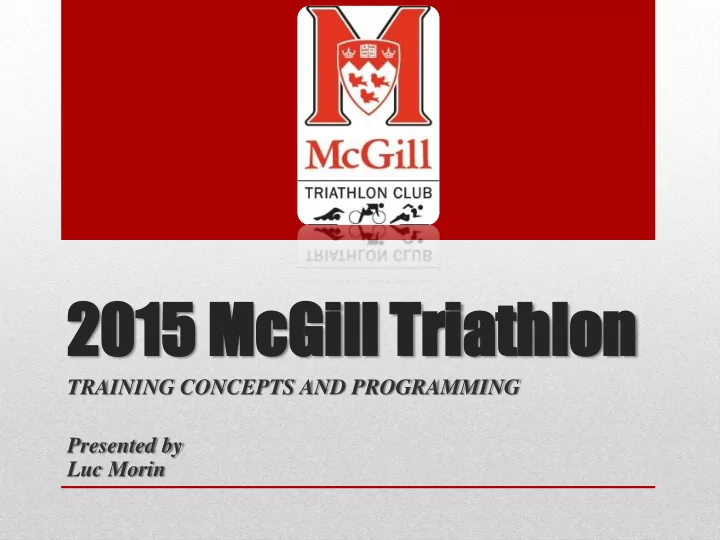

20 2015 15 McG McGill ill Tr Triathlon iathlon TRAINING CONCEPTS AND PROGRAMMING Presented by Luc Morin
• 1. Training vs. Working out (5min) • 2. Similarities and differences between Sports (10min) • 3. Similarities and differences between distances (10min) • 4. Training zones (10min) • 5. Polarized training (10min) • 6. How to plan a season (10min) OVERVIEW
Do you know the difference between training and working out? Training is when you have a progressive plan with measurable goals and continual challenges. Working out is anything that makes you sweaty and tired but not necessarily better because it lacks consistency, direction and specificity Key Components of Training: • Objectives – races and markers • Periodization – time period and focus • Measurable goals – time, intensity, volume • Reliable & valid outcomes – paces & duration TRAINING vs. WORKOUT
Is triathlon one or 3 sports? For many years, triathlon was seen as a combination of 3 distinctive sports. Where athletes would systematically apply different programs for each sports. Similarities: Energy Systems Cadence Technique Sports’ interrelations SPORTS’ SIMILARITIES
Is triathlon one or 3 sports? For many years, triathlon was seen as a combination of 3 distinctive sports. Where athletes would systematically apply different programs for each sports. Differences: Muscles & Angle Technique Sports ’ interrelations SPORTS’ DIFFERENCES
What are the difference between distances? Until recently, new athletes would start with a sprint distance, experienced athletes would do long distance, and fast athletes would do Olympic Distance . . . How has this changed? Similarities: 3 sports Technique Training Volume Training Intensity DISTANCES’ SIMILARITIES
What are the difference between distances? Differences: Race’s Energy System Tactic Nutrition Equipment DISTANCES’ DIFFERENCES
What are training zones and how do they apply? Training zones makes you a better athlete by causing physical stress, which in turn leads to adaptation of the body. Different types of training stress the body in different ways, and so lead to different types of adaptation. One needs to do a combination of types of training so that all the components of your performance are improved. Main Training Zones* Speed (97% +) VO2 (95-97%) Threshold (85-90%) Endurance (under 70%) * Terminology used for McGill’s Program. % represents maximal aerobic capacity. TRAINING ZONES
HR max INTENSITY VO2 max TRAINING 95% max HR threshold threshold 90% max HR THRESHOLD 85% max HR VO2 max threshold INTENSITY ATHLETIC POTENTIAL ENDURANCE TRAINING DURATION TRAINING ZONES
What is polarized training? “Keeping hard training hard and easy training easy” • Large volumes of low-intensity training to maximize peripheral adaptations • Small volumes of high-intensity training to optimize signaling for enhanced cardiac function. • Not so well-trained athletes require 2-3 times longer period to reach the same level of recovery after Threshold • Rapid recovery critical to tolerating the typical twice-daily training observed among endurance athletes. Endurance: 75-80% Endurance to Threshold: 10-5% Threshold & Speed: 15-20% * % represents the total intensity per week during transmutation (intensive weeks) POLARIZED TRAINING
How does it apply? • A polarized-training approach appears to be optimal. • Appropriate high-intensity interval training: • 1-3 sessions for elite athletes training 10-13 times a week. • 1-2 sessions for moderately-trained athletes training 5-8/week. • 1 session for less-trained athletes training 3-5/week • Cautious not to overprescribe high-intensity interval training or exhort the advantage of intensity over volume. • FORM = Fitness + Freshness POLARIZED TRAINING
• Set Goals: What do you want to accomplish this season? • Evaluate Race Demands: Race demands largely dictate the nature your training should take. • Establish Calendar: Using a calendar, mark down your A-priority event. 8-12 weeks is a reasonable amount of time. • Periodize: Divide your time up into blocks of 3-6 week periods. Ideally you will end up with about 4 periods, a couple of peak weeks and a race week. • Recovery Weeks: Every 3-4 week period should end with a rest and recovery week or low intensity week • Daily Workouts: scheduling two to three key workouts for the week and then fill in the less important sessions as time allows. • Follow the Plan : Stick to your plan and you’ll get the results you desire. Be patient. Planning a Season
EXTRA POLARIZED TRAINING
McGill’s training zones Endurance 1 @ 60-70% Endurance 2 @ 70-80% Sub-@ 80-85% Threshold @ 85-90% above Threshold @ 90-92 % VO2 @ 95-97% Le Meur, Yann. Sport et vie, no 140, Sept-Oct. 2013 POLARIZED TRAINING
McGill’s training zones Endurance 1 @ 60-70% Endurance 2 @ 70-80% Sub-@ 80-85% Threshold @ 85-90% above Threshold @ 90-92 % VO2 @ 95-97% Midgley, AW et al. (2007). Sports Med, 37, 857-880. Seiler, S & Tonnessen, E (2009). . Sportsci, 13, 32-53. POLARIZED TRAINING
Recommend
More recommend